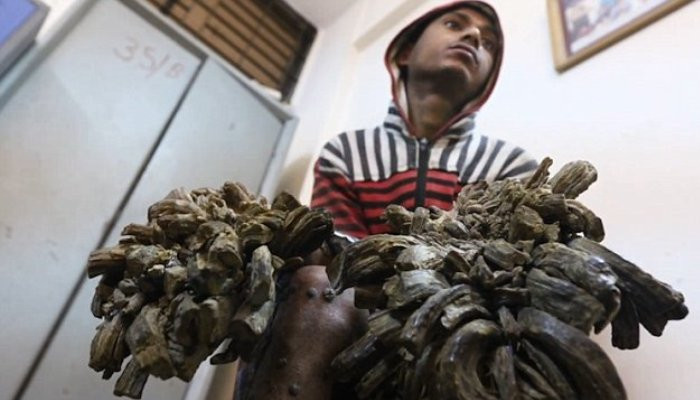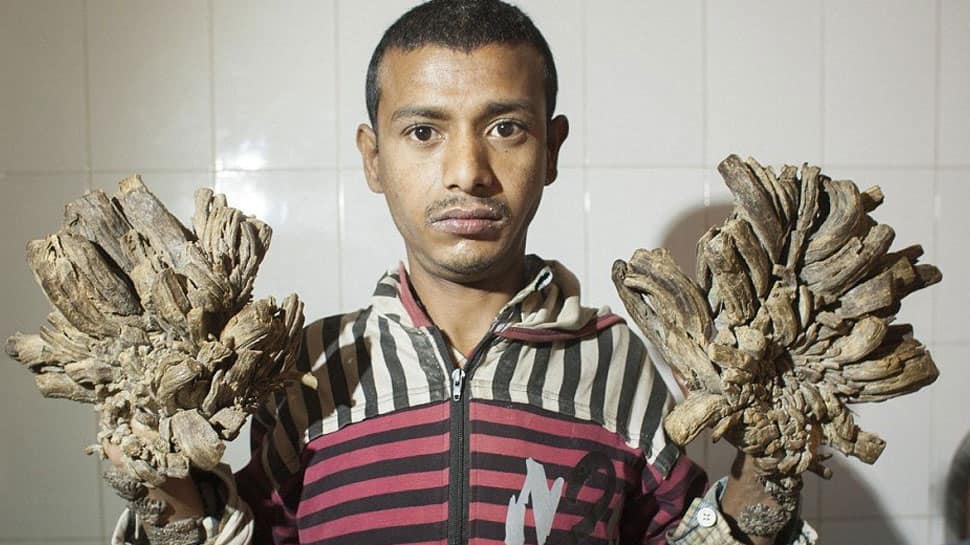Introduction

“Tree Man” Syndrome, formally known as epidermodysplasia verruciformis (EV), is a rare but physically and mentally taxing condition that causes warts that resemble tree branches to spread all over the body at rapid rates. EV is inherited through a gene mutation which makes the people affected highly susceptible to human papilloma virus (HPV). HPV is extremely common; in fact over 100 different strains of this virus exist. However, the Genetic and Rare Diseases Information (GARD) estimates that approximately 200 people worldwide are experiencing EV. Living with EV makes fighting off HPV extremely difficult to combat as the genetic mutation causes a defect in the immune system. Unfortunately, there are no definitive cures; treatments have been met with varying levels of success.
What is it?
There has been an increasing amount of focus on EV after a Bangaldeshi man made headlines for this condition in 2016, though much remains unknown about this condition due to its rarity. What we do know is that this condition typically manifests itself from childhood with the presentation of small warts; in fact, approximately 7.5% of cases manifest during infancy, 61.5% of cases develop during childhood, and 22% of cases develop during puberty. As the child gets older, their lesions become increasingly larger and appear at a faster rate as EV causes a defect in the immune system that makes the individual more susceptible to HPV, particularly HPV5 and HPV8 are found in 80% of all cases.
Eventually, some of these lesions can become cancerous. The most common skin cancer that presents itself in EV is squamous cell carcinoma. 30% – 60% of all patients with EV develop squamous cell carcinomas when they are around 40 to 50 years old. Squamous cell carcinoma is often caused by prolonged exposure to ultraviolet light from sources like the sun or artificial light. Thus, it is often recommended for those with EV to avoid staying in areas with high UV radiation exposure for extended periods of time. This recommendation arose from the fact that 30% – 60% of all patients with EV develop squamous cell carcinomas when they are around 40 to 50 years old.
In terms of genetics, EV has often been associated with an autosomal recessive inheritance pattern (two mutated genes are required to inherit the disease, one from each parent), though other reports that EV is sex linked, sporadoic, or even autsomal dominant inheritance(one mutate gene is required to inherit the disease). Though, there is some agreement over which genes and chromosomes are affected: the EVER1 and EVER2 genes of Chromosome 17. It is here that the proteins that, “form a complex with the zinc transporter protein (ZnT-1) in the endoplasmic reticulum of keratinocytes (aka skin cells)” are created. Zinc is thought to play an important role in wound healing and it may provide an explanation as to why EV occurs. In order to confirm this hypothesis, extensive research must take place.
Symptoms
The most notable symptom of EV are the growths that resemble branches. This is the most severe symptom of this condition. Other presentations of EV include flat topped papules, a small bump on the skin, that can vary in color from pink, white, red, brown, or violet, scaly and inflamed patches of skin called plaques, and brown warts. These lesions most commonly develop in areas that are exposed to sunlight: hands, feet, earlobe, face.
In addition to these physical symptoms, EV can be particularly detrimental to one’s self esteem. EV gets in the way of daily tasks and the lack of research surrounding EV often causes those who suffer from the condition to feel stigmatized. Though, to the recent interest in this condition, researchers hope that there may be new opportunities to understand the mechanisms of this troubling disease.
In July 2019, a 44 year-old man named Mahmoud Taluli underwent four successful surgeries over the span of two years to remove the lesions from his hands. His multiple surgeries included a team of doctors making deep, precise incisions in order to remove thousands of lesions. The doctors performed multiple skin grafts to help the body heal. Despite the fact Tauli underwent extensive treatment, the results of his surgeries are not permanent. His growths continued to develop and he is scheduled to have more surgeries. After receiving the surgeries Taluli was reported saying, “After years of suffering and solitude, I can finally live a normal life. I can play with my children. I can go to family events. I no longer need to cover my hands when I go out in public.”
Treatment
However, not everyone who experiences this condition experiences the same results. Abul Bajandar, a Bangladeshi man, asked doctors to amputate his hand. He underwent over 20 surgeries to remove the branch-like growths but they have been met with mixed success; his growths continued to form typically larger and faster than before. Recent surgeries, have been tremendously more successful, removing majority of the lesions, but he must go back to return the remaining lesions. Though, some doctors are concerned that he returned too late and the lesions may be incredibly difficult to remove yet again,


Finding a treatment is imperative as 50% of patients with EV have lesions that become malignant. However, researchers are met with a unique challenge as so little is known about this condition. Other than surgery, treatment includes topical retinoids (medications that reduce skin inflammation), interferon-alpha (a drug that contains compounds that suppress the cell cycle), and Cryotherapy (freezing off the growths).
Conclusion
“Tree Man” disease, or epidermodysplasia verruciformis, is an incredibly detrimental disease to an individual. Not only does this disease cause self esteem issues, it can also be the cause of a number of much more serious, non-cosmetic medical issues like HPV and squamous cell carcinoma. Despite its rarity, researchers are optimistic they will be able to find a working cure for EV due to the recent interest in this disease.
References
- Headlines Suggest ‘Tree Man Syndrome’ Curable? (2017, January 28). Retrieved September 30, 2020, from https://www.acsh.org/news/2017/01/11/headlines-suggest-tree-man-syndrome-curable-10711
- Rettner, R. (2019, July 10). ‘Tree Man’ Gets Pioneering Surgery for Rare Skin Condition. Retrieved September 30, 2020, from https://www.livescience.com/65907-tree-man-gaza-surgery.html
- Epidermodysplasia verruciformis. (n.d.). Retrieved September 30, 2020, from https://rarediseases.info.nih.gov/diseases/6357/epidermodysplasia-verruciformis
- Uddin, K., Amin, R., Majumder, S., Aleem, M., Rahaman, A., Dity, N., . . . Uddin, M. (2018, June 5). An ANKRD26nonsense somatic mutation in a female with epidermodysplasia verruciformis (Tree Man Syndrome). Retrieved September 30, 2020, from https://www.ncbi.nlm.nih.gov/pmc/articles/PMC6099040/
- Ngan, V. (n.d.). Epidermodysplasia verruciformis. Retrieved September 30, 2020, from https://www.dermnetnz.org/topics/epidermodysplasia-verruciformis/
- Orth G. Genetics of epidermodysplasia verruciformis: Insights into host defense against papillomaviruses. Semin Immunol. 2006 Dec;18(6):362-74. doi: 10.1016/j.smim.2006.07.008. Epub 2006 Oct 2. PMID: 17011789.
- Pokharel, S., & Regan, H. (2019, January 21). Bangladesh’s ‘tree man’ is back in hospital and needs more surgery. Retrieved October 13, 2020, from https://www.cnn.com/2019/01/21/health/tree-man-bangladesh-surgery-intl/index.html
- Stub, S. T. (2019, July 08). Patient With ‘Tree Man’ Syndrome Says He ‘Can Finally Live A Normal Life’. Retrieved October 13, 2020, from https://www.npr.org/sections/goatsandsoda/2019/07/08/738907620/patient-with-tree-man-syndrome-says-he-can-finally-live-a-normal-life

Leave a comment